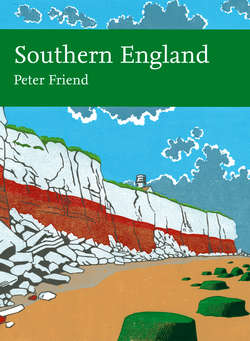Читать книгу Southern England - Peter Friend - Страница 42
Landscape D: New Red Sandstone and younger bedrock
ОглавлениеAlong the eastern edge of Area 2, relatively unfolded New Red Sandstone of Permian and Triassic age rests on the folded Devonian and Carboniferous sediments of Landscapes B and C. The junction of the younger material with the older was formed when the younger sediment was deposited on the eroded margins of the Variscan hills. The New Red Sandstone occurs in a wide, north-south trending belt, extending southwards as far as Torquay (d1) and Paignton, and with fingers extending westwards to the north of Dartmoor (Fig. 37). Along the coast, from Exmouth (d4) southwards via Dawlish (d3) and Teignmouth (d2), the New Red Sandstone has been quarried and penetrated by the tunnels of the main coastal railway to the Southwest. The sandstone forms dramatic red cliffs, and marks the western edge of the World Heritage Site that extends to the east along the coast of Dorset.
The New Red Sandstone consists of sandstones, gravels and mudstones that formed as alluvial fans, desert dunes and in short-lived lakes along the edge of an irregular hilly landscape of older bedrock. The characteristic red colour so typical of many Devon soils has largely been derived from these New Red Sandstone rocks. In the Exeter area (d5), roads have been spectacularly cut through the New Red sediments, and also through some scattered deposits of volcanic rock, mainly lava. These lavas have been highly altered and have not resisted weathering at the surface any more than the sediments of the succession, so they have not had much influence upon the scenery.
An intriguing feature of the New Red Sandstone is the way the original landscape on which it formed is reappearing as the present landscape erodes. For example, the Crediton Basin (d6), north of Dartmoor, is now obvious as a remarkably finger-like strip of sediment, only 2–3 km across north to south, but extending almost 40 km west to east (Fig. 37). Detailed examination of the New Red sediment in this basin shows that it was deposited as the fill of a long, narrow valley, with material being derived from north and south as well as along its length from the west. The valley formed parallel to the folds and faults of the earlier Carboniferous bedrock on each side of it, and must have been cut first by river erosion in Permian times, controlled by the earlier folds and faults that were formed during the Variscan mountain convergence. A few kilometres further north, the Tiverton Basin in Area 3 has a similar west-to-east trend, though it is more open and less elongate.
From Exeter (d5) to Torquay (d1), the base of the New Red Sandstone reveals topography of hollows eroded westwards into a higher ground of Devonian and Carboniferous bedrock. The New Red Sandstone pattern is of alluvial fans radiating downstream, but generally draining towards the east, and it bears a striking general similarity to the present drainage and scenery of the area (Fig. 77). During Variscan convergence, the Devonian limestones were moved into their present pattern by flat-lying faults, and this was then followed by the intrusion of the Dartmoor granite, which may help to explain why the New Red valleys here were shorter than those preserved as the Crediton (d6) and Tiverton basins.
FIG 77. Reconstruction of the Permian topography and drainage, looking southwards towards the location of present-day Torquay (Fig. 66, d1). The current coastline is indicated purely for reference; there is no evidence for a sea in Permian times where the sea now is.
I have already described the importance of the Devonian limestones in creating topography in the Torquay area (d1) and around Torbay generally. This material is an important part of the bedrock in its own right, and has been quarried widely as a building stone. It was a popular stone for ornaments and furniture, particularly in Victorian times, when cut and polished fossil corals featured in many of the washstands that were produced in the period.
In Torquay the Kent’s Cavern complex of caves, formed by solution of Devonian limestones, is an important archeological site, preserving evidence of Heidelberg and Neanderthal man from deposits about 450,000 years old. These were deposited during the Anglian cold phase of the Ice Age, when ice sheets spread across East Anglia and into the Thames valley, though not into the Southwest. The remains of cave bears, hyenas and sabre-tooth cats have also been found in the cave complex, as well as those of modern humans.
